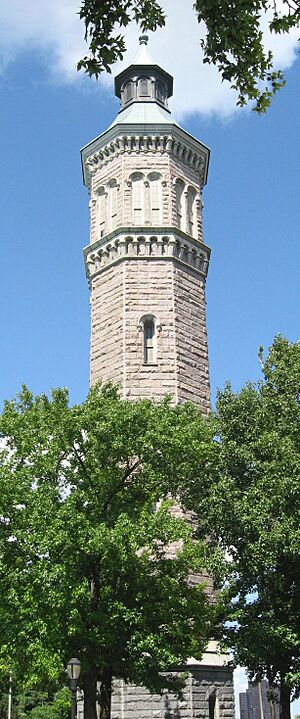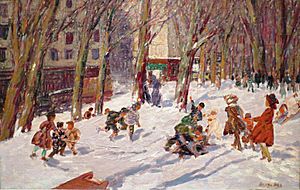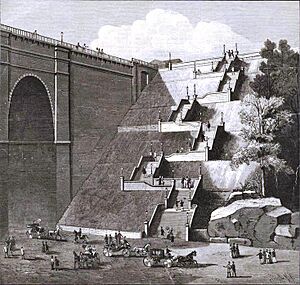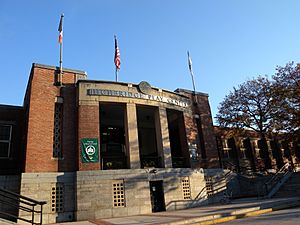Highbridge Park facts for kids
Quick facts for kids Highbridge Park |
|
|---|---|

Highbridge Play Center
|
|
| Type | Urban park |
| Location | Washington Heights, Manhattan, New York City |
| Area | 119 acres (48 ha) |
| Created | 1865 |
| Operated by | NYC Parks |
| Public transit access | Subway: Bus: M2, M3, M98, M100, M101, Bx3, Bx6, Bx6 SBS, Bx11, Bx13, Bx35, Bx36 |
Highbridge Park is a cool public park in Washington Heights, Manhattan, New York City. It's located on the western side of the Harlem River. The park stretches from 155th Street all the way to Dyckman Street in Upper Manhattan.
The New York City Department of Parks and Recreation takes care of the southern part of the park. A non-profit group called the New York Restoration Project helps maintain the northern half. Some of the most famous spots in the park are the High Bridge, the High Bridge Water Tower, and the Highbridge Play Center.
Contents
Park History
How the Park Started
Highbridge Park gets its name from the High Bridge. This bridge was built in 1848 and is New York City's oldest standing bridge. It was made to carry water from the Old Croton Aqueduct over the Harlem River.
For a long time, from the 1600s to the 1800s, this area didn't have many people. There were just a few farms and private homes. During the American Revolution, General George Washington even used the Morris–Jumel Mansion, which is next to the park, as his headquarters in 1776.
The land for Highbridge Park was gathered bit by bit between 1867 and the 1960s. The park was designed in 1888 by Samuel Parsons Jr. and Calvert Vaux. From 1895 to 1914, an amusement park called Fort George Amusement Park was located in the area between 190th and 192nd Streets. Today, that spot is a seating area in Highbridge Park.
In 1887, the park was even the location for the USA Cross Country Championships. In the 1890s, New York City built a racetrack for horses, called the Harlem River Speedway, right along the riverbank of the park.
The 1900s
Early 1900s Changes
More land was added to the park in the early 1900s. This included the cliffside area from West 181st Street to Dyckman Street in 1902. The land with Fort George Hill was added in 1928. In 1934, the Department of Parks also got the Highbridge Tower and the old Highbridge Reservoir site.
In the early 1900s, wealthy New Yorkers would walk along the wide paths in the park. They could access the Harlem River and enjoy horseback riding and other outdoor activities. However, by the 1920s, dirt and materials from building the new Washington Heights neighborhood started to harm the park.
Building During the Great Depression
In 1934, Robert Moses, a city leader, became the commissioner of the New York City Department of Parks and Recreation. This was during the Great Depression, a time when many people didn't have jobs. Moses wanted to create jobs and improve the city.
He planned to build many new pools and bathing areas across the city. Highbridge Park was chosen as one of these locations. The pools were built using money from the Works Progress Administration (WPA). This was a federal program created to help people find work during the Depression.
Moses and architects Aymar Embury II and Gilmore David Clarke designed 11 pools to be built at the same time. Each pool complex would have separate pools for diving, swimming, and wading. They would also have bleachers, viewing areas, and bathhouses with locker rooms. The buildings were designed in the Streamline Moderne and Classical styles, using affordable materials.
Construction for the Highbridge Pool began in October 1934. It was the fifth of these new pools to open, welcoming visitors on July 14, 1936. The complex included a large main pool and a wading pool.
Later 1900s Developments
In 1940, Robert Moses changed parts of the Harlem River Speedway into the Harlem River Drive. This was a six-lane highway. This change blocked public access to the riverfront, which some people felt "ruined" the park.
The Highbridge Play Center bathhouse was updated in the 1960s. The High Bridge walkway was closed to the public around 1970.
By the 1970s, many city parks, including Highbridge Park, were in poor condition. In 1982, the NYC Parks budget increased, allowing for many restoration projects. The Highbridge Park pool was one of these projects. The play center and pool were completely renovated and reopened on June 14, 1985.
Despite improvements, the park still faced challenges. In November 1991, the water tower was restored. Since 1999, the New York Restoration Project, led by Bette Midler, has been working to make the park better. The park also received renovations in 1996, including new filtration and heating systems for the pool.
The 2000s
On May 19, 2007, the first legal mountain bike trails and dirt jumps in New York City opened in Highbridge Park. The New York City Mountain Bike Association worked with NYC Parks to design these trails.
Around 2010, the old Harlem River Speedway area was improved. It reopened as part of the Manhattan Waterfront Greenway, a path along the river.
By late 2011, even with all the efforts, some parts of the park were still falling apart. In 2013, the city announced plans for a skatepark under the Hamilton Bridge, which opened the next year. The city also planned for an ice-skating rink in 2014, but this plan was later put on hold.
A community effort helped get money to fix the High Bridge. The restored bridge reopened on June 9, 2015. However, some parts of the park, especially south of the Washington Bridge, remained overgrown. The northern section, maintained by the NYRP, was very clean.
In 2016, about $30 million was set aside for more improvements to the park's fun areas. This was part of the city's Anchor Parks program. The first phase of renovations began in December 2018. This included better lighting and paths, cleaning a large section of the park, and restoring the "Grand Staircase." It also added a "welcome garden" at Dyckman Street and an accessible entrance at 184th Street. The second phase started in July 2019. This phase included restoring the water tower and the Adventure Playground at 164th Street.
Park Attractions and Facilities
Playgrounds for Fun
Highbridge Park has six playgrounds for kids to enjoy:
- Adventure Playground: Located at 164th Street and Edgecombe Avenue. It was built in 1973, inspired by adventure playgrounds in Europe. It has been updated several times since.
- CPF Playground: Found at 173rd Street, close to the pool.
- Fort George Playground: At Fort George Avenue and St. Nicholas Avenue. It's named after Fort George, and it used to be the site of the Fort George Amusement Park. The playground was added to the park in 1928 and restored in 1999.
- Quisqueya Playground: At 180th Street and Amsterdam Avenue. "Quisqueya" means "cradle of life" and honors the local Dominican community. This playground was built in 1934 and restored in 1998.
- Sunken Playground: At 167th Street and Edgecombe Avenue.
- Wallenberg Playground: At 189th Street and Amsterdam Avenue.
High Bridge Water Tower

The High Bridge Water Tower is in the park between West 173rd and 174th Streets. It was built between 1866 and 1872 to help provide more water to the city. The tower is 200 feet tall and has eight sides. It was designed by John B. Jervis in a mix of Romanesque Revival and neo-Grec styles.
The High Bridge water system started working in 1872. It reached its full capacity by 1875. Later, with a new water system, the High Bridge system was used less. In 1949, the tower was disconnected from the water system. In 1958, a carillon (a set of bells) was installed in the tower. The tower was repaired and restored between 1989 and 1990.
Highbridge Play Center
The Highbridge Play Center is on Amsterdam Avenue between West 172nd and West 174th Streets. It was built from 1934 to 1936 during the time of Mayor Fiorello LaGuardia. The main architect was Aymar Embury II, and the landscape architect was Gilmore D. Clarke. It was built where the old reservoir for the High Bridge Water Tower used to be. The center has a swimming pool.
The Bathhouse
The bathhouse sits on a stone base above the street. The rest of the building is made of brick. It's shaped like a rectangle. The main entrance is on Amsterdam Avenue and 173rd Street. Stone stairs on both sides lead up to the entrance. The entrance has two brick towers with flagpoles and a sign that says "Highbridge Play Center."
The north and south sides of the building have the locker rooms for women and men. They look almost the same. Ramps lead from the ends of each side. The eastern side of the building is similar to the western side. It also has entrances to the locker rooms and a bronze clock.
The Pools
The Highbridge Pool area has two rectangular pools: a main pool and a wading pool. The main pool is about 228 feet wide and 165 feet long, and it's 10.5 feet deep. The wading pool is 228 feet wide and 97 feet long.
A wide path surrounds the pool area on three sides. There are concrete bleachers (seats) north of the pool area. A short brick wall surrounds the pools, and there are more seating areas along the eastern side. Stairs just east of the pool area lead to the High Bridge. The water tower is at the northeast corner of the pool area.
Important Park Designations
The High Bridge Water Tower was named a New York City landmark in 1967 by the New York City Landmarks Preservation Commission. This means it's a special building that is protected because of its history and design. The Highbridge Play Center was also named a New York City landmark in 2007.





